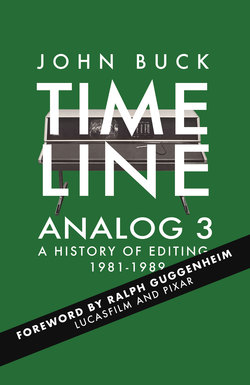Читать книгу Timeline Analog 3 - John Buck - Страница 15
На сайте Литреса книга снята с продажи.
PAINTBOX
ОглавлениеOne company that understood the limits of storage and instant recall was Quantel of the UK. Quantel had previewed a prototype of the Paintbox at NAB 1981 and the team of Roddy Pratt, Tony Searby and Rick Brunwin had spent the following year building the production version.
The shipping Paintbox relied heavily on technology that it shared with the Quantel DLS6000 still store system including storage subsystems, CPU cards and some video processing cards. Pratt recalls:
At this point, the familiar Paintbox 'look' started to form. The second terminal was replaced by on-screen menus accessible by 'swipe' gestures and features like library browsing, text compositing, masks and cutouts all appeared. The on-screen text for the menu s was created by digitizing letters from a sheet of transfer lettering and storing them as a 'font', I don't even want to think about the copyright implications! From a technical aspect, what amazes me in hindsight is how much of the system was "custom".
The digitizing tablet was based on a normal Summagraphics one, but with the stylus totally redesigned to give pressure sensitivity, now it was based on a Parker pen 'chassis' fitted with a pressure transducer which was prone to fracturing if artists pressed too hard!
The storage system used 'off the shelf' winchester disks with SMD interfaces, but all controller boards were custom designed. Even the 8" floppy disk used for single-picture backup required a custom controller board to squeeze the 1.2MB required for a picture and stencil onto a single disc.
Broadcast networks, production companies and post-houses rushed to use the futuristic device that allowed artists and designers to draw and paint with an electronic stylus. Quantel decided to use a touch-tablet and pen, rather than a mouse. The pressure-sensitive pen was another breakthrough as it allowed artists to control, in a natural way, the opacity of the paint applied to their canvas. The paint actually mixed with the colours already on the canvas.
The Paintbox's real-time graphics were unsurpassed in quality and became crucial to the on-air look of its first customers The Weather Channel, MTV and the BBC. Roger Thornton from Quantel recalls:
It was not only the broadcasters that took to the Paintbox; postproduction houses too quickly saw its potential and ads such as the Crown Paints 'painting by numbers' and music videos such as director Steve Barron's seminal 'Money for Nothing' for the band Dire Straits, quickly demonstrated its enormous potential.
The Paintbox gave television producers the ability to create 2-D visuals that had not been accessible away from mainframes and dedicated hardware previously and it hinted at what might be possible with digital editing if the right hardware and software could be built.
With the rise of affordable chip processing power and the widespread acceptance of personal computers there was a window of opportunity for other companies to take Quantels’ lead and deliver similar capabilities to smaller companies. The two companies that changed broadcast graphics were Dubner and Cubicomp.
